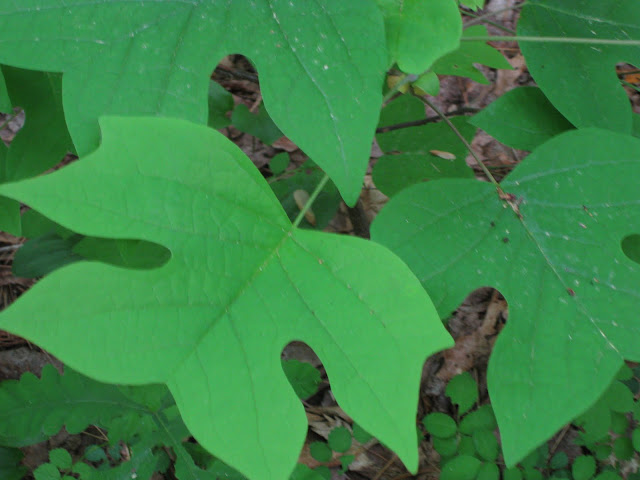I would love to be that kind of person who can look at a landscape and conclude what kind of soil, minerals and elevation we are dealing with, what animals we are likely to run in to, what other plants we can expect to see, and the history and present of the place. One thing not many of us know is that pretty much all of Massachusetts was farmed - there were no woods left at all for centuries.
Today, animal pastures or farm fields have again returned to the forested state they once were in. The trees are slowly but methodically taking back the land they were once cleared from. But if you know what to look for you can see the traces of the farm uses. An interesting book on this subject is "Reading the forested landscape" by Tom Wessels. He teaches how to read signs of the forest that will tell if it has been fire, farm or storm that shaped a landscape. He also tells how the Native Americans treated the land - they used fire and controlled burns to prevent the woods from growing too dense and too hard to hunt in.
Right at the beginning of the trail was a planting with the Columbines above. Then we immediately entered the dark moist woods and battled mosquitos with one spray bottle after another. I still have like a hundred bites, at least that's what it feels like.
We soon saw a Witch hazel. What Boot teaches us is to learn tricks to identify what we see, and Witch hazel has a number of things unique - one of them being this little leaf gall called Witch's cap.
A gall is a plant's response to something that attacks it. An insect or a fungus start to damage the plant, and the plant then grows an abnormal growth to protect itself. There are thousands of different galls and they can be very helpful in identifying something.
Then we saw this little Tulip tree, also easy to recognize - no other tree has leaves like this.
The path took us to a clearing next to a field. There we saw plants that thrive in that particular environment. Sumacs, flowering Blackberries and Multiflora rose grew wild in a happy entangled thicket.
For a moment I paid no attention to our guide, and I sat down in the tall grass next to the field.
A straw of grass is an infinite world. Sit down and you'll hear an endless buzz of thousands of creatures, for whom this grass is all there is.
A stinkbug.
A catydid?
And who knows his name and what part he plays in his little universe.
An intense color and fragrance.
The path moved on, wild Grape vines forming an arch above us.
Poison Ivy and Virginia Creeper vines climbed up the tallest trees.
And there she was! Almost following us from tree to tree. A few minutes later we saw her with a chipmunk hanging from her sharp talons.
A great Jack-in-the-pulpit:
And some Meadow Rue which I absolutely adore.
Another favorite which I never have seen in the wild before is the Pagoda Dogwood tree, called so because of it's branching. There were several beauties blooming.
Some flowers up close
Some parts of the river had really expanded, but it didn't seem to bother these cherry trees in bloom.
The shagbark Hickory looks like something from a fairy tale.
This is Hop Hornbeam.
We left the riverside, passed through a dense Hemlock forest where I was happy to see no signs of the Wooly Adelgid. Then we were greeted with this beautiful sight:
Sunlit American Chestnut leaves. They were small root sprouts of a former stand of big Chestnuts who since have been killed by the blight. We saw several healthy ones, and a few that was girdled about 3 ft from the ground by the fungus. Everything above the girdle was dead, but below it there was still healthy branches. The roots of the old ones are still alive, but when they die, that might be the very end of it, unless they manage to breed a new variety that has stronger resistance to this disease.
We also saw this funny looking sprouts on a Sweet Birch. Most likely some kind of gall, but no one really knew why it grew in this manner. It didn't seem to harm the rest of the tree.
These guys somehow reminded me of kittens or soft furry puppies all hanging out together in a soft cuddly mass. Tent caterpillars can also be destructive I'm sure, but perhaps people mostly don't like them because of the ugly "tents" they build?
Plants are always under attack from a variety of enemies: insects, fungi, bacteria, viruses. When I heard a lecture in plant pathology I remember thinking it was surprising anything survived at all. But plants have defenses that can keep them strong in many ways - unless the onslaught is too strong at once. This Arrowwood Viburnum stand no chance against these Viburnum Weevils that quickly defoliates the plant completely. A plant without leaves cannot survive.
And at last a greeting from a busy frog in the shallow pool. Arcadia is a great park with a visitor's Center and many activities year round. Hope you get a chance to see it some day!



























Wonderful hike, with lots to enjoy. Thanks for taking us along.
ReplyDelete